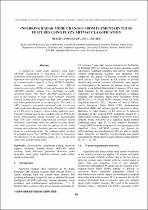 ResearchSpace
ResearchSpace
Inferring radar mode changes from elementary pulse features using Fuzzy ARTMAP classification
JavaScript is disabled for your browser. Some features of this site may not work without it.
- ResearchSpace
- →
- Research Publications/Outputs
- →
- Conference Publications
- →
- View Item
| dc.contributor.author |
Potgieter, PF

|
|
| dc.contributor.author |
Olivier, JC

|
|
| dc.date.accessioned | 2007-11-14T12:59:25Z | |
| dc.date.available | 2007-11-14T12:59:25Z | |
| dc.date.issued | 2007-11 | |
| dc.identifier.citation | Potgieter, PF, Olivier, JC. 2007. Inferring radar mode changes from elementary pulse features using Fuzzy ARTMAP classification. 2007 International Conference on Wavelet Analysis and Pattern Recognition. Beijing, China. 2-4 November 2007, pp 6 | en |
| dc.identifier.isbn | 1-4244-1066-5 | |
| dc.identifier.uri | http://hdl.handle.net/10204/1567 | |
| dc.description | Copyright: 2007 IEEE | en |
| dc.description.abstract | A method for radar mode inference using Fuzzy ARTMAP classification is presented. In this method elementary radar parameters, Pulse Width (PW) and Pulse Repetition Interval (PRI) originating from a radar operating in a certain mode is input to a Fuzzy ARTMAP classifier. Radar parameters were simulated at different signal-to-noise ratios (SNRs) to train and evaluate the Fuzzy ARTMAP classifier without prior knowledge of radar operating modes. Thus Fuzzy ARTMAP classification is used in the analysis of radar mode behaviour. Training resulted in map field weights with high code compression and broad generalization of the input space. The choice of ARTa categories accurately correlated with the current radar mode input data presented to the classifier. It resulted in a 1.8% error in category choice (radar mode) at worst. Classifier training may be done on data with low SNR as the broad generalization during training will accommodate high SNR data without compromising accuracy during evaluation. Knowledge about the amount of radar modes and mode transition can also be gained by an initial training and evaluation (analysis) process to assign pseudo modes to a particular radar. The resultant modes can then be included into a Fuzzy ARTMAP classifier by increasing the dimension of the predicted output, B to classify both radar class and operating mode. | en |
| dc.language.iso | en | en |
| dc.publisher | IEEE | en |
| dc.subject | Electronic warfare | en |
| dc.subject | Fuzzy ARTMAP | en |
| dc.subject | Match tracking | en |
| dc.subject | Mode inference | en |
| dc.subject | Parameter detection | en |
| dc.subject | Pulse descriptor word | en |
| dc.title | Inferring radar mode changes from elementary pulse features using Fuzzy ARTMAP classification | en |
| dc.type | Conference Presentation | en |
| dc.identifier.apacitation | Potgieter, P., & Olivier, J. (2007). Inferring radar mode changes from elementary pulse features using Fuzzy ARTMAP classification. IEEE. http://hdl.handle.net/10204/1567 | en_ZA |
| dc.identifier.chicagocitation | Potgieter, PF, and JC Olivier. "Inferring radar mode changes from elementary pulse features using Fuzzy ARTMAP classification." (2007): http://hdl.handle.net/10204/1567 | en_ZA |
| dc.identifier.vancouvercitation | Potgieter P, Olivier J, Inferring radar mode changes from elementary pulse features using Fuzzy ARTMAP classification; IEEE; 2007. http://hdl.handle.net/10204/1567 . | en_ZA |
| dc.identifier.ris | TY - Conference Presentation AU - Potgieter, PF AU - Olivier, JC AB - A method for radar mode inference using Fuzzy ARTMAP classification is presented. In this method elementary radar parameters, Pulse Width (PW) and Pulse Repetition Interval (PRI) originating from a radar operating in a certain mode is input to a Fuzzy ARTMAP classifier. Radar parameters were simulated at different signal-to-noise ratios (SNRs) to train and evaluate the Fuzzy ARTMAP classifier without prior knowledge of radar operating modes. Thus Fuzzy ARTMAP classification is used in the analysis of radar mode behaviour. Training resulted in map field weights with high code compression and broad generalization of the input space. The choice of ARTa categories accurately correlated with the current radar mode input data presented to the classifier. It resulted in a 1.8% error in category choice (radar mode) at worst. Classifier training may be done on data with low SNR as the broad generalization during training will accommodate high SNR data without compromising accuracy during evaluation. Knowledge about the amount of radar modes and mode transition can also be gained by an initial training and evaluation (analysis) process to assign pseudo modes to a particular radar. The resultant modes can then be included into a Fuzzy ARTMAP classifier by increasing the dimension of the predicted output, B to classify both radar class and operating mode. DA - 2007-11 DB - ResearchSpace DP - CSIR KW - Electronic warfare KW - Fuzzy ARTMAP KW - Match tracking KW - Mode inference KW - Parameter detection KW - Pulse descriptor word LK - https://researchspace.csir.co.za PY - 2007 SM - 1-4244-1066-5 T1 - Inferring radar mode changes from elementary pulse features using Fuzzy ARTMAP classification TI - Inferring radar mode changes from elementary pulse features using Fuzzy ARTMAP classification UR - http://hdl.handle.net/10204/1567 ER - | en_ZA |





